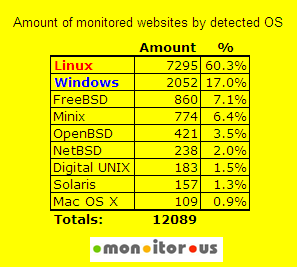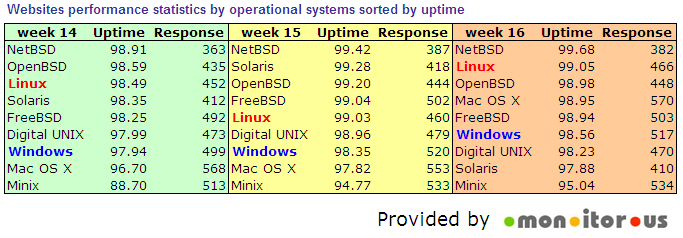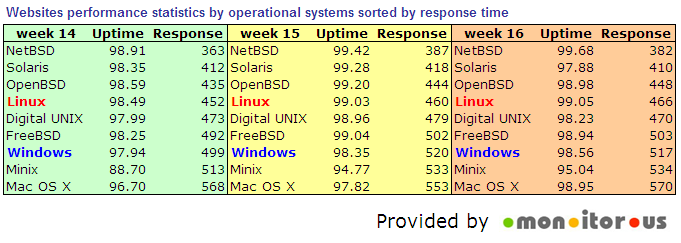Everything about Web and Network Monitoring
by Hovhannes Avoyan | Apr 30, 2007
There are many factors which affect Website availability and performance from end user perspective, namely ISP Internet connection, server location, server parameters, programming language, application architecture and implementation. One of the critical parameters is a selected Operational System (OS). Most users often need to select between Linux and Windows, two popular choices for web servers. By providing free monitoring service, we at monitor.us collected large amount of data to perform a unique analytical research examining OS correlation with uptime and performance.
By performing heuristic OS detection procedures, we come up with statistics which may be interesting for our community. We could detect OS platform for around 13,000 websites (while the monitoring base is much higher we either could not detect the OS or the detection likelihood was bellow a reasonable threshold). After removing less frequent OS-es we got 12,089 sites by Week 16. The OS allocation is the following:

The data illustrates obvious leadership of Linux (60%), with Windows being the next (17%). Almost 2/3 of our
community use Linux as an OS platform.
Next we analyzed the uptime and response speed per each Operating System. We are monitoring every 30min simultaneously from 3 locations in the USA, Germany, and Austria, so we are performing 1,008 checks per week per each website. That means for example that we made for detected Linux servers 7,295*1,008 = 7,353,360 checks in week 16. Similarly we did 2052*1008= 2,068,416 checks for Windows servers in the same week. That gives us a solid base for OS to OS comparison, assuming that we may neglect other differences (e.g. in each group there will be similar per cent of good ISPs, good application designs, etc.). When we calculate averages and sort data by uptime we got the following pictures (per week):

It shows NetBSD as a clear leader in uptime. BSD severs and Solaris also in general demonstrate high uptime. Linux was ahead of Windows every week by more than 0.5%. For your understanding 0.5% downtime means 50 minutes per week, or 216 minutes or 3 hours 36 minutes per month. The cost of 1 minute of downtime depends on your business but typically if you are running a business application it could be quite high (e.g. see /?page_id=10) – up to several thousands and even tens of thousands. One of the reasons for lower uptime for Windows is the reboots needed for Windows after patches, updates and installations.
Another important parameter is the response time –how long it takes for a user to get a webpage after submitting the http request. We sorted by average response time per OS platform and the picture is the same on week to week comparison:

Again NetBSD is a performance leader, followed by Solaris and OpenBSD. Linux was ahead of Windows by around 50 milliseconds faster response.
Summarizing, statistically Linux based servers provide better availability and response speed than Windows servers. Absolute leader is NetBSD in both categories; OpenBSD and Solaris also demonstrate good results.
We hope this data will be valuable for our community in their hosting selection process.
[tags] Linux, Windows, NetBSD, Solaris, OpenBSD, performance, uptime, monitor.us, monitoring, website monitoring, OS, website performance, website uptime [/tags]
Category: Articles | Tagged Comments Off









